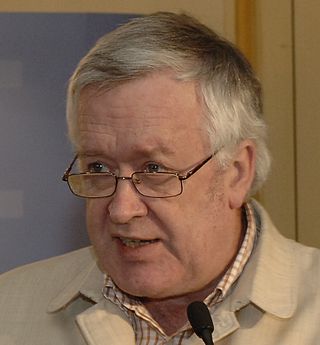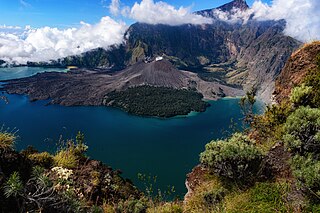
Paleoclimatology is the scientific study of climates predating the invention of meteorological instruments, when no direct measurement data were available. As instrumental records only span a tiny part of Earth's history, the reconstruction of ancient climate is important to understand natural variation and the evolution of the current climate.

The volcanic winter of AD 536 was the most severe and protracted episode of climatic cooling in the Northern Hemisphere in the last 2,000 years. The volcanic winter was caused by at least three simultaneous eruptions of uncertain origin, with several possible locations proposed in various continents. Most contemporary accounts of the volcanic winter are from authors in Constantinople, the capital of the Eastern Roman Empire, although the impact of the cooler temperatures extended beyond Europe. Modern scholarship has determined that in early AD 536, an eruption ejected massive amounts of sulfate aerosols into the atmosphere, which reduced the solar radiation reaching the Earth's surface and cooled the atmosphere for several years. In March 536, Constantinople began experiencing darkened skies and lower temperatures.

A volcanic winter is a reduction in global temperatures caused by droplets of sulfuric acid obscuring the Sun and raising Earth's albedo (increasing the reflection of solar radiation) after a large, sulfur-rich, particularly explosive volcanic eruption. Climate effects are primarily dependent upon the amount of injection of SO2 and H2S into the stratosphere where they react with OH and H2O to form H2SO4 on a timescale of a week, and the resulting H2SO4 aerosols produce the dominant radiative effect. Volcanic stratospheric aerosols cool the surface by reflecting solar radiation and warm the stratosphere by absorbing terrestrial radiation for several years. Moreover, the cooling trend can be further extended by atmosphere–ice–ocean feedback mechanisms. These feedbacks can continue to maintain the cool climate long after the volcanic aerosols have dissipated.

Hans von Storch is a German climate scientist. He is a professor at the Meteorological Institute of the University of Hamburg, and Director of the Institute for Coastal Research at the Helmholtz Research Centre in Geesthacht, Germany. He is a member of the advisory boards of the journals Journal of Climate and Annals of Geophysics. He worked at the Max Planck Institute for Meteorology from 1986 to 1995 and headed the Statistical Analysis and Modelling research group there.
Huaynaputina is a volcano in a volcanic high plateau in southern Peru. Lying in the Central Volcanic Zone of the Andes, it was formed by the subduction of the oceanic Nazca Plate under the continental South American Plate. Huaynaputina is a large volcanic crater, lacking an identifiable mountain profile, with an outer stratovolcano and three younger volcanic vents within an amphitheatre-shaped structure that is either a former caldera or a remnant of glacial erosion. The volcano has erupted dacitic magma.
Jan Esper studied geography at the University of Bonn, where he later earned his doctorate. After a postdoc position at Columbia University in New York City, he continued his work on dendrochronology at the Swiss Federal Institute for Forest, Snow and Landscape Research (WSL), and qualified as a professor at the University of Bern. In 2018, Esper became a member of the Academy of Sciences and Literature. Since 2010, he has been a professor at the Department of Geography at Johannes Gutenberg University Mainz.
Teleconnection in atmospheric science refers to climate anomalies being related to each other at large distances. The most emblematic teleconnection is that linking sea-level pressure at Tahiti and Darwin, Australia, which defines the Southern Oscillation. Another well-known teleconnection links the sea-level pressure over Iceland with the one over the Azores, traditionally defining the North Atlantic Oscillation (NAO).

The Subboreal is a climatic period, immediately before the present one, of the Holocene. It lasted from 3710 to 450 BCE.
The Subatlantic is the current climatic age of the Holocene epoch. It started about 2,500 years BP and is still ongoing. Its average temperatures are slightly lower than during the preceding Subboreal and Atlantic. During its course, the temperature underwent several oscillations, which had a strong influence on fauna and flora and thus indirectly on the evolution of human civilizations. With intensifying industrialisation, human society started to stress the natural climatic cycles with increased greenhouse gas emissions.

Climate change in California has resulted in higher than average temperatures, leading to increased occurrences of drought and wildfires. During the next few decades in California, climate change is likely to further reduce water availability, increase wildfire risk, decrease agricultural productivity, and threaten coastal ecosystems. The state will also be impacted economically due to the rising cost of providing water to its residents along with revenue and job loss in the agricultural sector. California has taken a number of steps to mitigate impacts of climate change in the state.

A megadrought is an exceptionally severe drought, lasting for many years and covering a wide area.

Climate change in Africa is an increasingly serious threat as Africa is among the most vulnerable continents to the effects of climate change. Some sources even classify Africa as "the most vulnerable continent on Earth". This vulnerability is driven by a range of factors that include weak adaptive capacity, high dependence on ecosystem goods for livelihoods, and less developed agricultural production systems. The risks of climate change on agricultural production, food security, water resources and ecosystem services will likely have increasingly severe consequences on lives and sustainable development prospects in Africa. With high confidence, it was projected by the IPCC in 2007 that in many African countries and regions, agricultural production and food security would probably be severely compromised by climate change and climate variability. Managing this risk requires an integration of mitigation and adaptation strategies in the management of ecosystem goods and services, and the agriculture production systems in Africa.

The Late Antique Little Ice Age (LALIA) was a long-lasting Northern Hemispheric cooling period in the 6th and 7th centuries AD, during the period known as Late Antiquity. The period coincides with three large volcanic eruptions in 535/536, 539/540 and 547. The volcanic winter of 536 was the early phenomenon of the century-long global temperature decline. One study suggested a global cooling of 2 °C (3.6 °F).

In 1257, a catastrophic eruption occurred at Samalas, a volcano on the Indonesian island of Lombok. The event had a probable Volcanic Explosivity Index of 7, making it one of the largest volcanic eruptions during the Holocene epoch. It left behind a large caldera that contains Lake Segara Anak. Later volcanic activity created more volcanic centres in the caldera, including the Barujari cone, which remains active.
A very significant heat wave occurred in Europe in July 1757. The heat wave may have been the hottest summer in Continental Europe between the summers of 1540 and 2003. July 1757 was the hottest month in the history of Paris with an average temperature of 25 °C (77 °F), and it reached a high of 37.5 °C (99.5 °F) on 14 July. Similarly, over Central England, July 1757 was the hottest month on record since 1659, at the time, and would not be beaten until July 1783. It still is the ninth-warmest on record in that series.

Lisa J. Graumlich is an American paleoclimatologist who studies the interactions between the climate, ecosystems and humans. She is the inaugural dean of College of the Environment at the University of Washington. Graumlich is a Fellow of the American Association for the Advancement of Science and the Ecological Society of America, and is president-elect of the American Geophysical Union.

The Medieval Warm Period (MWP), also known as the Medieval Climate Optimum or the Medieval Climatic Anomaly, was a time of warm climate in the North Atlantic region that lasted from c. 950 to c. 1250. Climate proxy records show peak warmth occurred at different times for different regions, which indicate that the MWP was not a globally uniform event. Some refer to the MWP as the Medieval Climatic Anomaly to emphasize that climatic effects other than temperature were also important.
Rosanne D'Arrigo is a professor at Lamont–Doherty Earth Observatory at Columbia University known for her research into climate change using dendrochronology, or dating based on tree rings.

The southwestern North American megadrought is an ongoing megadrought in the southwestern region of North America that began in 2000. At least 24 years in length, the drought is the driest multi-decade period the region has seen since at least 800 CE. The megadrought has prompted the declaration of a water shortage at Lake Mead, the largest reservoir in the United States. Climate change models project drier conditions in the region through the end of the 21st century, though climate change mitigation may avoid the most extreme impacts.

Heinz Wanner is a Swiss geographer and climate researcher. He is a professor emeritus and works at the Oeschger Centre for Climate Change Research of the University of Bern.
![The Schwedenfass [de]
in the Staatlicher Hofkeller Wurzburg [de]
was created to host the "once-in-a-millennium wine" of 1540 Residence Wurzburg - Wine cellar 2.JPG](http://upload.wikimedia.org/wikipedia/commons/thumb/0/08/Residence_W%C3%BCrzburg_-_Wine_cellar_2.JPG/220px-Residence_W%C3%BCrzburg_-_Wine_cellar_2.JPG)












